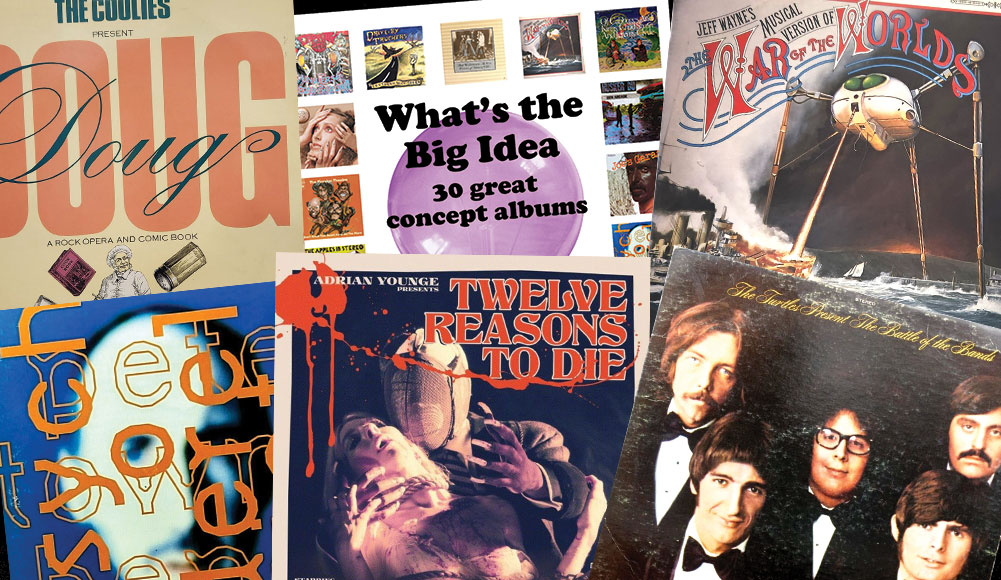Author and journalist Bill Kopp wrote his third rock-centered book, this one with some more obscure concept albums. He’s conducted more than 1,300 interviews and published more than 5,000 pieces (features, interviews, reviews, essays), including many in Good Times. His first book was Reinventing Pink Floyd: From Syd Barrett to The Dark Side of the Moon. His second book was a history of an important Bay Area punk and new wave record label: Disturbing the Peace: 415 Records and the Rise of New Wave. What’s the Big Idea is his third book.
What drew you to the concept album theme for a book?
I’ve always been inspired by songwriters. At their best, singles are the distillation of all of the musical virtues an artist can muster, packed into two or three minutes. Albums are an extension of that: a collection of songs the artist wants the world to hear. By that measure, I see concept albums as the next logical extension: swinging for the fences with an idea too big for one song. I wanted to initiate a book-length exploration of concept albums as a way to open a window into the creative process.
Do you have a number for how many concept albums have been recorded?
No! For what it’s worth, Wikipedia lists nearly 1,000, and I know of at least a few that aren’t on that list.
You are clearly going for the lesser-known albums. Why?
I would respectfully take issue with that assertion. Jeff Wayne’s Musical Version of the War of the Worlds was a smash success nearly everywhere except the U.S., and a popular stage show still runs in London. Jethro Tull’s Thick as a Brick reached #1 on the Billboard 200 and earned a Gold Record. Ghostface Killah’s 12 Reasons to Die was widely reviewed and made it to #27 on the mainstream Billboard 200. I could go on!
My choices reflected a goal of emphasizing that concept albums have been released consistently throughout the last 50-plus years, and in most every genre, and to shine a light on some great ones listeners may have missed. Plus, plenty has been already written about the most well-known concept albums; I didn’t want to cover well-trodden ground.
What was the first concept album you fell in love with?
Probably Hope by Klaatu. They were the anonymous Canadian band who became the subject of a rumor: Were they the Beatles in disguise? (Short answer: No.) Their second album was an ambitious work that took the music in the direction that Electric Light Orchestra had started to pursue before veering off into more mainstream pop.
What’s the difference between a concept album and a rock opera?
A rock opera is a subset of the concept album. In my view, a concept album is any record with a central theme. Maybe it’s a narrative, maybe it’s a lyrical focus, maybe it’s a central musical motif. Anything with a big idea at its core can be a concept album.
If you had to recommend one and only one of these albums, which would it be and why?
For me, that answer changes from day to day. For rock fans, I’d certainly recommend Pete Townshend’s Psychoderelict from 1993. Fans who appreciate Tommy and Quadrophenia should really hear that album. It was released at the height of grunge, a time when hardly anyone was interested in conceptual works. Psychoderelict sold in small numbers and received poor reviews. But it’s fascinating, entertaining, has a great narrative, and the music is great.
Ask me again tomorrow and I might suggest Doug, a bizarre 1988 rock opera by Atlanta musical pranksters The Coolies. It’s the most obscure title on the list—out of print, not on Spotify—but it’s wickedly brilliant, with dead-on and hilarious musical pastiches of The Replacements, The Who, John Lennon, Beastie Boys and more. Its storyline is offensive and extremely politically incorrect (though the villain gets his comeuppance in the end), but Doug is well worth tracking down for the open-minded.
Like all lists, this one is infuriating and enlightening. You’ve turned us on to some obscure ones and missed some that I would have thought would be mandatory: Lola vs the Powerman and the Moneygoround; Ziggy Stardust; The Wall, which you mention. How did you strike the balance, and are you happy with it? I could see a bigger book, of at least 100.
I was committed to 100% firsthand research, and that meant only covering albums for which I could talk to an album’s creator or a key participant. Neither Ray Davies nor Roger Waters was available in the required timeframe, and of course Bowie has left us. All that said, I already have a list for a second volume, should I decide to pursue that path.
I sought a balance that would appeal to both hardcore music fiends and to casual readers interested in the creative process. I wanted to keep the book accessible, and if I covered 100 albums, (a) the book would have been 750 pages and very expensive and (b) I wouldn’t be finished writing it yet.
Rick Wakeman and Patrick Moraz…but no Tales from Topographic Oceans?
I’m a huge fan of Yes—I’ve interviewed nine current or former members—but I tend to agree with Wakeman’s view on Tales: it’s a bit ponderous. There are a lot of great concept albums out there, but I focused only on records I can recommend with unreserved enthusiasm.
What got you started writing about music? What was the first album you bought? Vinyl, CD, digital…what’s your preference?
I knew I wanted to be a music journalist from the time I was a kid of 11 or so. I’ve been writing about music since the mid-1990s, but I got heavily into it just over 20 years ago, and writing has been my full-time endeavor and livelihood for more than a decade now. The first album I bought with my own money was The Beatles 1962-1966, on cassette, in 1974.
I definitely prefer vinyl; I have about 6,000 LPs and use my turntables nearly every day. But I also have several thousand CDs, thousands of albums in hi-res digital format, and a vintage jukebox full of 45s.













